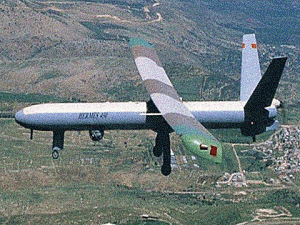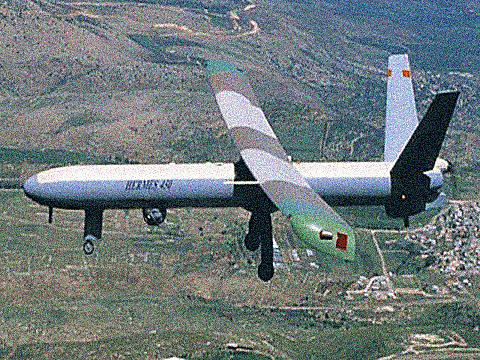
A kinder, gentler drone?
The suggestion that drones be used as tools of humanitarianism is well-intended, yet highly impractical. Though it is significantly important for the world to see what is happening inside Syria, resources and efforts can be better placed elsewhere than flying drones over that country, such as working steadfastly at having the opposing sides agree to a cease fire and to negotiate a resolution to the conflict before an all-out conflagration into civil war; it is the only tangible way forward, especially since Assad is highly unlikely to voluntarily step down.
Never mind that violating Syrian airspace is a violation of sovereignty under international law, the Syrian government’s forces, backed by Russian military hardware, would not sit idly by while drones hover and buzz over Homs or Damascus, monitoring the Assad government’s crackdown on the Syrian people. The Syrian regime is equipped with a hefty air defence system, consisting of Russian-made S300 surface-to-air missiles, widely seen as one of the most efficient anti-aircraft missile systems currently fielded. This effectively renders the use of larger drones to be futile as they would most likely be brought down. The Assad forces are also equipped with Russian MiG-29 fighter jets which can easily intercept any non-stealth drone in Syrian airspace.
Further, as mentioned above, the use of drones over Syria would break one of the basic tenets of international law by violating the territorial integrity of a sovereign state. Such a violation of another country’s airspace by a foreign entity would require the approval of that country’s government (such is the case in Iraq and Pakistan) or the United Nations Security Council (UNSC), which includes veto-wielding permanent members, Russia and China, who have considerable interests in the stability of Syria and the Assad regime in particular. This has been demonstrated through their recent veto of a UNSC resolution condemning the Syrian government’s actions, for which they feared the language of the resolution would permit foreign military intervention if necessary.
Assad is Russia’s chief ally in the Middle East, and Syria is home to the only Russian military base outside the former Soviet Union. Russian arms manufacturers also have lucrative arms deals with Assad that they would like to see through. These reasons would likely propel the Russians to veto any resolution authorizing the use of drones over Syria, unless perhaps if it is clearly stipulated in any UNSC resolution that the drones’ sole purpose is to monitor and record the onslaught on the Syrian streets.
China’s interest in Syria mostly rests in its interest in Syrian oil. In the eyes of Beijing, human rights can take a back seat to Syria’s oil exports, especially since China’s National Petroleum Corporation is in a joint-venture partnership with Syria’s national oil company.
Additional questions arise when considering the difficulty in distinguishing between humanitarian drones flown by non-governmental human rights organizations and those flown by the Pentagon. How would the ordinary Syrian on the street be able to distinguish between a drone that has been predominantly used as a weapon of war in places such as Pakistan and Somalia and a drone used entirely for surveillance purposes and which intends no harm?
One can also argue that the use of drones for surveillance would erode basic civil liberties; however, this argument can be morally circumvented in the event of a humanitarian crisis where innocent civilians are being harmed and brutalized. Nonetheless, this argument does merit attention.
Also, who is to say that if the United States (or NGOs funded by the United States) uses drones over countries like Syria, that countries such as China would not reciprocate and use drones over the airspace of US allies? What would the U.S. reaction be? Is the United States ready for that type of reciprocity?
The idea of drones as surveillance tools that would capture images of the horrific scenes on the streets of Syria is one that merits further thought and discussion. However, as it stands, the above noted obstacles would prevent the use of drones over Syria.
Smaller, radio-controlled drones, operated by local handlers would be more efficient as they do not attract as much attention as their larger counterparts; however, as the authors of the New York Times Op-Ed note, local handlers could be put at risk in this scenario. Another option is to use stealth-drones, such as the American RQ-170 Sentinel. This drone could be useful in humanitarian-centric scenarios due to its invisibility and ability to loiter above a specific area at high-altitude. However, its reliability is put into question given that one of these drones recently went down in Iran in December 2011.
With the above in mind, it is quite evident that there are serious obstacles preventing humanitarian drones from taking to the skies to spy on “evil”. It is also clear that there have been too many fatalities over the past year in Syria. History has taught us that it is usually political will, not insufficient information, which has been the barrier to intervening in defence of human rights. Drones would only be able to record the humanitarian crisis for the world to see, while the power to put an end to the violence rests with Assad, the Syrian opposition, and ultimately, the people of Syria.
Navid Hassibi is a PhD student in political science (University of Antwerp) and a Canadian civil servant. The views expressed here are solely his own.

